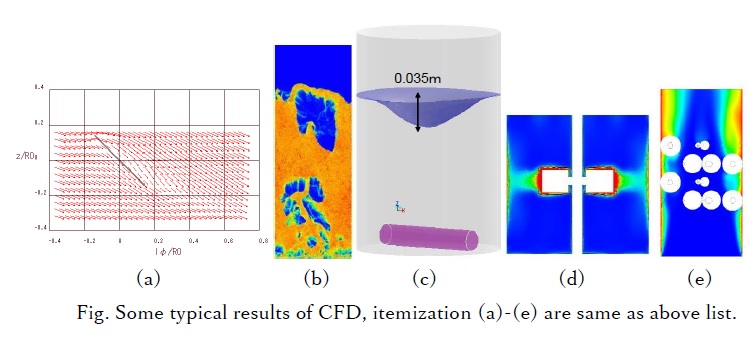
Recently, researchers and engineers in chemical companies are facing a huge variety of flows such as multiphase flows, non-isothermal flows and flows with moving boundaries. In other hand, high quality computing becomes more important. Some member in Japanese chemical companies formed a workshop for workers on the first wave of computational fluid dynamics (CFD) in 2008, which is called as chemical company workshop on CFD (CCW)(Ishiba et al., 2010, Ishiba et al., 2013 and Kawada et al. 2017).
In this presentation, we introduce our activities and current state of affairs. As regards the quality improvement of CFD, we compared numerical results in some problems:
(a) Turbulent flow in an agitation vessel
(b) Flow in a fluidization bed
(c) Vortex generation in a swirling flow
(d) A dispersed liquid-liquid two phase flow
(e) Heat transport in packed column
We have discussed that “how do CFD engineers provide better precisions for designing chemical reactors” and “what is useful for guidance of CFD” in the last decade. We need not only development of hard ware and software, but also development of qualified engineers to keep better productions. We expect that the discuss efforts of CCW is contributing sustainable productivity by using CFD.

Nowadays an internal 3D structure of porous material is noninvasively analyzed with sub-micron resolution using X-ray micro-CT technology for understanding of internal phenomena. It is then expected that the important properties such as reaction efficiency, effective diffusion coefficient, permeability, thermal conductivity, mechanical strength will be predicted and designed based on the relation between the microstructure and these properties. However, a geometrical descriptor, which is an index to quantify the microstructure, can be arbitrarily defined, and hence, its appropriate selection to serve the material design is challenging and needs expert knowledge.
Therefore, this study proposed a machine learning-based framework to select the descriptors of microstructure for predicting specific material properties. For its validation, the relation between the descriptors and one specific material property of more than 1000 porous material samples were analyzed. The values of defined 62 geometrical descriptors were calculated using CT scan images. The specific porous material property was obtained by numerical simulations.
The framework employed RReliefF algorithm as filter method and support vector machine as wrapper method. Although the wrapper method is computationally expensive, its numerical load was reduced using RReliefF based on a descriptor ranking of importance to the specific material property. The framework selected 8 descriptors to minimize the prediction error for permeability. Among them, the conventional descriptors such as porosity, specific surface area, tortuosity, and hydraulic radius were also included, which validated the framework. Other selected descriptors were related to chord lengths of pores in three directions, which implied that the three-dimensional shape of pores caused the difference in the permeability of porous material with similar conventional parameters' values. It should be emphasized that the proposed framework is applicable to the identification of descriptors for predicting any specific material properties, which might not be related to the microstructure of porous material in the past.
Stir tank bioreactors are widely used for mammalian cell culture process for biomanufacturing. From the process development to manufacturing, various size of bioreactors are used. To enable successful scale-up, Number of factors are critical to efficient cell growth and substance production. Regarding process parameters of bioreactor, liquid mixing and gas transfer efficiency are well understood for the key process parameter and evaluate those of parameter are applied as an indicator to scale up to larger process. Volumetric mass transfer coefficient (kLa) is widely used to determine gas transfer capacity of bioreactor. kLa is affected by the bioreactor design such as impeller, vessel height and diameter, gas sparger shape and capacity. The kLa have been correlated as following equation.
kLa of bioreactors that used for process development to commercial scale has been determined by the equation. Many of engineering approach are discussed to determine kLa. Bioreactors have multiple sparger to supply oxygen for various culture condition, the generated bubbles also have different diameters and size distribution. It affects the specific interfacial area, but the size of bubble and distributions has not been verified well.
In this study, we discuss about kLa determination approach with bubble diameter and size distribution analysis regarding for the series of MobiusR bioreactor. The bioreactor family is single use bioreactors by configured flexible film-based bag for all liquid contact surface as single time usage. The bioreactor series has five tank sizes, 3L vessel for early process development, 50-200L for pilot-scale manufacturing, 1000-2000L for clinical scale manufacturing. kLa performance that of the bioreactor series are already published, but the correlation of engineering parameters from modeling are not well characterized yet. We verified kLa performance of the bioreactors with general mechanical models and analyze correlation between kLa to sparged bubble specifications. also discuss the unique sparger design and characterization.

While understanding the intrinsic reaction kinetics is a perpetual pursuit of chemical science, the effective reaction kinetics most frequently faced in chemical engineering is typically significantly different from it. The coupling of reaction and diffusion is a major cause of this difference and is hence a common topic for both chemistry and chemical engineering. It is, however, a challenge topic owning to its multi-scale nature with reaction at atomistic scales and diffusion ranging from micro- to macro-scales. By simplifying the particle-particle interactions in molecular dynamics (MD) with hard sphere (HS) models and improving its scalability in parallel computation with pseudo-particle modelling (PPM), the HS-PPM approach has been demonstrated effective for bridging the scales involved in reaction-diffusion coupling and advantageous over traditional MD or continuum-based simulation methods. The presentation will introduce the theories, models, algorithms, implementation and applications of this approach with example from petrochemical and coal-chemical industries.